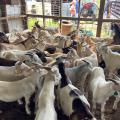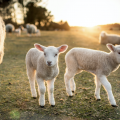Youth Programs
Small Ruminant Youth Programs
Club Goat

Dramatic growth in meat goat numbers has taken place in the Southeastern U.S. over the past 25 years. This growth filtered over into the junior livestock program and meat goats were added as project animals to teach life skills to young people. This addition created a demand for show quality club goats to be used in the junior livestock program. As a result, high quality club goats demand top prices as project animals. Market goats can be of any breed or cross breed of goat with the Boer crosses being the most preferred. Over the years a genetic base of meat goats phenotypically selected for the junior program has evolved. The opportunity to create a market for meat goats and provide a service to young people could never have come at a better time for Mississippi goat breeders. Market goats were added to the Mississippi 4-H Livestock Program in 1999 at the district show level prior to being added to the state level.
The Dixie National Round-Up in February is the most important show for market goat exhibitors in Mississippi. Market meat goats were added to Junior Roundup in 2001, with 67 total head exhibited. The champion goats were included in the Sale of Junior Champions at Dixie National in 2002. The Grand Champion that year sold for $2,862 and the Reserve Grand Champion sold for $2,400. Today all division champions are eligible for the sale as well as the Champion and Reserve Champion MS Bred market goat. A commercial meat goat doe show was added to the livestock program in 2009. MCGA sponsors additional premiums and awards to be earned on MS Bred goats showing in the State Fair and Dixie National Junior Round Up each year. Each exhibitor is allowed to show three head of market goats at Round Up provided one is MS Bred. Exhibitors can show up to six head of commercial does at Round Up.
The commercial meat goat industry in Mississippi is still growing with all classes of goats bringing extremely good prices. By industry standards, commercial market goats are ready for harvest at a weight somewhere from 40 to 100 pounds depending on the targeted market, with highest prices usually paid at the 60 to 80 pound weight range. Prices may vary based on size, breed type, sex, condition and weight. The market meat goat show follows this trend with top quality animals standing at the top of each division. The commercial doe show reflects the breeding side of the club goat project with those females projected to produce ideal club goat wethers placing at the top of these divisions.
Extra income derived from club goat sales is usually above expected income for any traditional market goat enterprise. Today, club goat prospects can sell for $500 or more at 8 to 10 weeks of age depending on quality. This extra value is dependent upon a demand for quality genetics that can provide a project animal which will last for the duration of the show year. Wethers (castrated males) or does (females) are eligible to show at the Dixie National Junior Round-Up market goat show, but market goats must be disbudded or have no more horn growth than 1 ½” above the skull. Does can only show in one show (either market or commercial doe). Does showing in the commercial meat goat doe show are allowed to have horns.
Visit the Mississippi Club Goat Association FaceBook page for more information.
Mississippi Bred Goat Program
The Mississippi Bred Goat Program is administered by the Mississippi Club Goat Association. This program was established to reward exhibitors for showing MS Bred goats. Breeders must purchase tags for each goat they intend to nominate for awards. (Forms are available from MCGA for tag purchase as well as replacement tags.) This money goes into a fund to be paid out to exhibitors based upon placing in the shows. Mississippi Club Goat Association pays premiums in the classes and rewards overall champions from this fund. All money received from the sale of MS Bred ear tags each year is given back to exhibitors as an additional premium or award. MS Bred ear tags must be in the ear of the nominated goat prior to ownership deadline. This is to insure that the goat has a tag at the time of nomination/retinal imaging for proper identification.
Visit the Mississippi Club Goat Association FaceBook page for more information.
Junior Meat Goat Program Overview
In Mississippi, market meat goats should be ready for harvest in terms of condition and arrive at their terminal show (Dixie National) at an ideal market weight range of 60 to 100 pounds to be competitive and to fit within industry standards.
For the Dixie National shows in February, a March/April born goat should meet ideal weight if carrying a high percent Boer influence. A February/March born kid may work better when there is less Boer influence genetics.
Ideally a market meat goat should not have shed the temporary incisors (milk teeth) prior to harvest or their final market show. A commercial meat doe kid must have retained their milk teeth or have no permanent incisors visible at the District show.
Both wether and doe kids are eligible to show in the market meat goat shows in Mississippi. However, the same doe kid cannot be shown in both the market and the commercial meat doe shows.
Market meat goats and commercial meat does can be of any breed or cross breed of goat with the Boer cross being the most preferred by meat goat exhibitors.
Publications
News
RAYMOND, Miss. -- Small ruminants are a popular choice for people like J.T. Crownover who want to get into the livestock business but do not want to raise cattle. Crownover attended the Central Mississippi Research and Extension Center’s Producer Advisory Council meeting Feb. 20. The forum, where agricultural producers can discuss their needs with MSU administrators, researchers, specialists and Extension agents, was the catalyst for the university’s active small ruminant program.
LEAKESVILLE, Miss. -- Most goat meat sold in the U.S. is imported, but a group of Mississippi meat goat producers wants to see that change. A first-of-its-kind test in the state is underway to help them meet that goal. The Southeastern Buck Performance Test aims to improve the profitability of the meat goat industry in the region by improving meat goat genetics.
Some people use lamb and sheep interchangeably to identify the animal, but they aren’t exactly the same thing. So, what’s the difference between them? Yes, lambs are baby sheep -- that’s the main distinction. But here are some other differences between the two:




